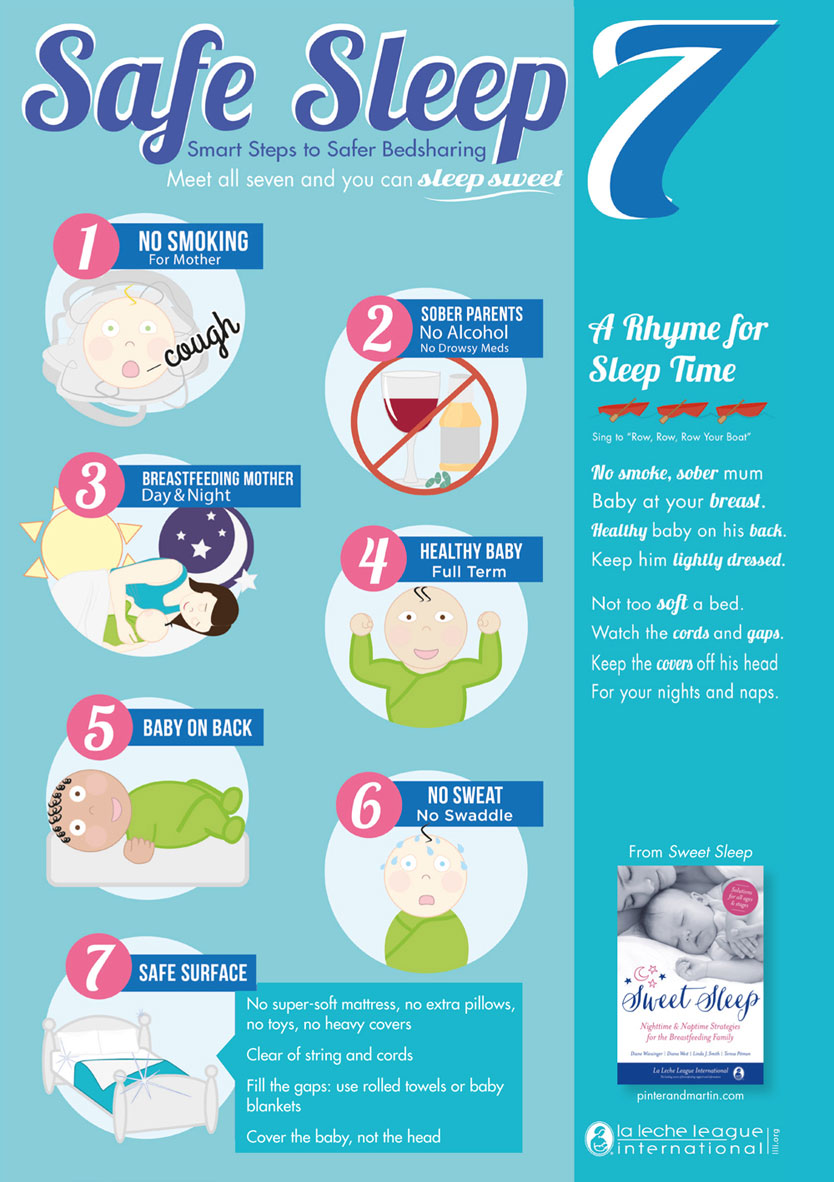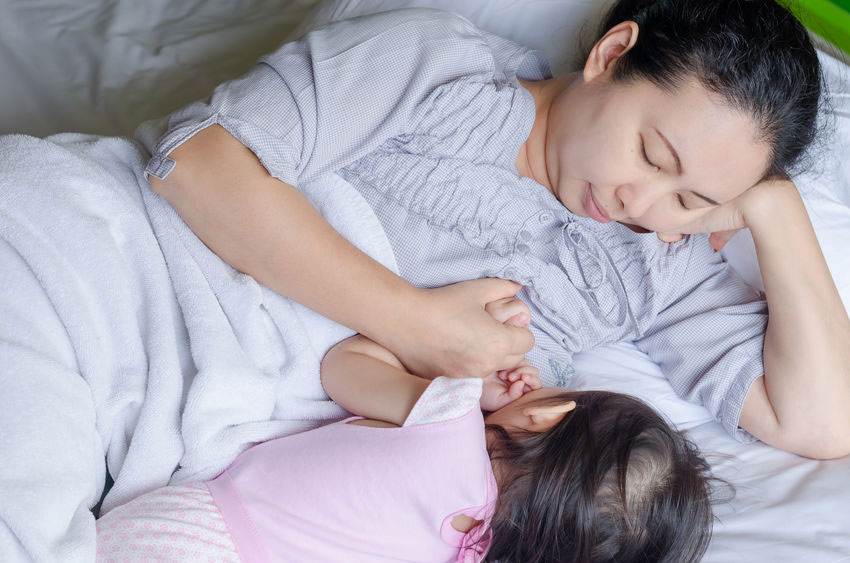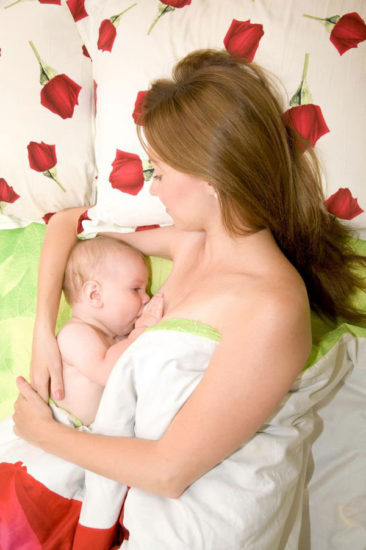Across the world mothers have always slept close to their babies at night, historically, there would have been no other way to keep babies breastfed, safe, warm and contented. By sleeping close to her baby, a mother can check on him regularly and respond quickly when he wakes—breastfeeding him back to sleep before either of them become wide awake.
This article
This article shares the recommendations for making your sleeping area as safe as possible if you are considering bringing your baby into your bed at nap-time or bed-time. By increasing awareness of the risks and benefits of bed-sharing with baby and of unsafe co-sleeping practices, parents can make their own informed choice about where their baby will sleep.
Co-sleeping options
Sleeping close or “co-sleeping” can include (1) room-sharing, where baby sleeps in his own cot close to his mother, or (2) bed-sharing when mother and baby share a sleep surface.
- Room-sharing day and night with baby sleeping in their own cot close to a parent for the first six months, is widely promoted as a safe place for a baby to sleep.1
- Bed-sharing with baby is a popular nighttime coping mechanism for parents since a baby wants to be close to his mother and often can’t sleep well without her. It makes breastfeeding easier, mothers like to be close to their babies to check on them through the night and it is often a cultural tradition. Safety concerns around bed-sharing include modern thick duvets (overheating risk), soft pillows/mattresses (suffocation risk) and high beds (risk of falls from the bed). However when safe bed sharing practices are followed, advisory bodies such as the National Institute for Health and Care Excellence (UK) and The Academy of Breastfeeding Medicine (USA) are supportive of parents deciding where their babies sleep:
The committee agreed that on the basis of the evidence presented, which showed no greater risk of harm when parents shared a bed with their baby compared to not bed sharing, healthcare professionals should not routinely advise parents against sharing a bed with their baby. They agreed about the importance of parental choice in relation to bed sharing with their baby assuming they follow safe practices for bed sharing.
Existing evidence does not support the conclusion that bedsharing among breastfeeding infants (i.e., breastsleeping) causes sudden infant death syndrome (SIDS) in the absence of known hazards
Safety issues: plan ahead
Research shows three quarters of breastfed babies sleep with their mother or parents some of the time in the early months.2 Many of these parents did not plan to bed-share but found their baby settled better and breastfeeding was easier. It is therefore important that all parents know the safety issues and how to bed-share safely, even if they don’t initially plan to take their baby into bed.3
Make your bed and bedding materials as safe as possible
- Avoid very soft bedding materials which are a suffocation risk (ABM, 2019); keep soft pillows and soft toys away from your baby in the bed, do not put your baby to sleep on a soft pillow
- Use light blankets—an adult duvet on your baby could cause him to get too hot
- Don’t overwrap your baby or block air movement across your baby’s face4.
- Consider the height of your bed and whether your baby could fall, see James McKenna’s Safe Co-sleeping Guidelines for a drawing of a safe arrangement or Safer Sleep for Babies a Guide for Parents, Unicef/BASIS/Lullaby Trust, 2019
- Fill any spaces beside the bed that could trap a baby
- Tie back a parent’s long hair to prevent baby getting tangled in hair

Do not…
#1 Do not smoke and bed-share
There is a strong association between Sudden Infant Death Syndrome or SIDS (unexplained deaths) and smoking exposure. Smoking around a baby has been shown to increase the risk of SIDS when using both cots and bed-sharing arrangements. The Lullaby Trust says that bed-sharing is not advisable if either parent is a smoker, even if they never smoke in the bedroom. 5 The risk of SIDS is said to be 10 times higher if a baby shares a bed with a smoking parent.6
With regard to room-sharing with a parent who smokes, the authors of Sweet Sleep, 2014 say:
Even if you or your partner smokes, most research and health organisations still suggest keeping your baby in your room at night for at least the first half-year. But you can minimise your baby’s nighttime exposure to smoke by keeping his bed away from yours, by bringing him into your bed only for feeds, and by staying between him and a partner who smokes.
James J. McKenna is Director of the Mother-Baby Sleep Laboratory, University of Notre Dame. His list of Safe Co-sleeping Guidelines explains that safe sleep starts with a smoke free pregnancy and continues with breastfeeding your baby and a continual smoke free atmosphere.
#2 Do not sleep with your baby on a sofa, armchair or waterbed
A sofa, settee, armchair or soft surface like a pillow are not safe spaces as a baby can get trapped in them (ABM, 2020). It is not recommended to bed-share on a waterbed either.7
Reason: the risk of SIDS is 50 times higher for babies when they sleep on a sofa or armchair with an adult. They are also at risk of accidental death as they can easily slip into a position where they are trapped and can’t breathe.
#3 Do not bed-share if you have taken alcohol or drugs
These substances, including some general medications, could change your awareness when you are asleep (ABM, 2019).
#4 Do not bed-share with your baby while bed-sharing with other children
Babies less than 12 months old should not sleep with other small siblings or pets. A responsible adult should be present at all times and a baby should not be left alone on an adult bed.89
#5 Do not lie your baby on his tummy to sleep
It is recommended that babies are placed on their backs to sleep not on their side or tummy (ABM, 2019). Nils Bergman has an interesting theory as to why this is protective.1011
Be aware that
- A premature or low birthweight baby has an increased risk of SIDS.12
- An obese parent may not be aware of their baby’s position in the bed.13 The Academy of Breastfeeding Medicine recommends further research into how maternal obesity may affect the risks and benefits of bed-sharing (ABM, 2019).
Breastfeeding and SIDS
Breastfeeding is associated with a lower risk of SIDS and formula is associated with an increased risk. The protective mechanism of breastfeeding is not fully understood but is thought to be connected to maternal behaviour (frequently monitoring baby and sleep position), the protective effects of breast milk on health and nutrition and a breastfed baby’s pattern of frequent waking to feed. (ABM, 2019)
Video studies in sleep labs and parental homes have shown that mothers frequently touch their babies, even when they are only half awake, monitoring the baby’s temperature and relationship to the bedding. Furthermore, mothers who usually sleep with their babies may be more likely to notice if their baby is unwell because of their proximity.
Protective sleep position
Breastfeeding mothers all tend to adopt the same protective position around their nursling when they bed-share. This is sometimes called the “C” position and the authors of Sweet Sleep call it the “cuddle curl” and describe it as follows:
During sleep you’ll automatically go into the same position as breastfeeding mothers all over the world and throughout time. It’s called a cuddle curl, and it’s nature’s way of protecting a baby during sleep. Your knees come up and your arm tucks under your head or pillow, or curls around your baby, creating a protected space. There’s no way for you to roll towards your baby because your bent legs won’t let you. And no one else can roll into the space because your knees and elbows are in the way.


What if I don’t breastfeed?
James McKenna recommends that babies who are bottle-fed should sleep on a separate surface close to their mother rather than in the bed (McKenna, 2016) but more research is needed into the safest sleeping arrangement for babies who are not breastfed (ABM, 2019). In the following video by Fox News, McKenna explains why not breastfeeding could be a concern when bed-sharing, due to changes in a baby’s arousal patterns and their sleep position in the bed. McKenna goes on to explain why he thinks breastfeeding is a prerequisite for bed sharing (watch from 6:15).
Absence of cuddle curl
One reason bed-sharing may be less safe for non-breastfeeders could be that they do not adopt the same protective cuddle curl position. BASIS explains:
One small study showed that mothers who did not breastfeed often placed their babies high in the bed, at parents’ face-height, positioned between, or on top of pillows. They did not consistently face the baby or adopt the “protective” sleep position. This suggests that bed-sharing may be less safe for non-breast-feeders,. A three-sided ‘bedside’, or ‘side-car’, crib which attaches to your bed may be a suitable option if you want to be close to your baby, but you have concerns about bed-sharing safety.
Absence of breastsleeping
McKenna and Gettler 14 have coined the term “breastsleeping” to acknowledge the specific ways a breastfeeding mother and baby differ from a mother and her bottle-fed baby during sleep. They explain this as follows:
- Normal infant sleep can’t be measured without breastsleeping because it is a highly balanced system between mother, baby and breast. The sensory exchanges between mother and baby, the arousal patterns, feeding frequency, and breastmilk itself—which influences infant metabolism—are all important protective factors.
- The breastsleeping mother and baby show very different behavioural and physiological characteristics compared to the bottle or formula feeding mother and baby who bed-share.
Further resources
For further help with evidence based information about safe sleeping arrangements for you and your breastfed baby see:
#1 Sweet Sleep: Nighttime and Naptime Strategies for the Breastfeeding Family, LLLI, 2014 (book)
A comprehensive, research based sleep book. Includes the Safe Sleep Seven—a checklist for safe sleeping for the breastfeeding mother, and how to make your bed as ‘SIDS-safe as a cot’. See my Sweet Sleep Book Review for further information.
Safe Sleep Seven
- No smoking for mother [or father]
- Sober parents. No alcohol. No drowsy meds
- Breastfeeding mother day and night
- Healthy baby full term [born after 37 weeks]
- Baby on back
- No sweat no swaddle
- Safe surface. No super-soft mattress, no extra pillows, no toys, no heavy covers. Clear of string and cords. Fill the gaps: use rolled towels or baby blankets. Cover the baby not the head.
#2 Safe Infant Sleep, James McKenna, 2020 (book)
James J. McKennna is an author and director of the Mother-Baby Sleep Laboratory, University of Notre Dame. His work includes Sleeping with Your Baby: A Parent’s Guide to Cosleeping, and many articles such as those referred to above and in further reading.
#3 BASIS—Baby Sleep Info Source (website)
A comprehensive website established by Helen Ball, a Professor of Anthropology at the Durham Infancy and Sleep Centre at Durham University. BASIS explains how babies sleep, what is normal, parents’ expectations, safety concerns and how to avoid dangerous situations. The site is supported by breastfeeding advocates Lactation Consultants of Great Britain, La Leche League GB, National Childbirth Trust, Breastfeeding Network and UNICEF and has a number of excellent information sheets which are freely downloadable.
The importance of safe sleep conversations
As more is learned, organisations who previously dismissed bed-sharing as dangerous are now recognising that parents need balanced information on safe co-sleeping arrangements including bed-sharing.
Remember, shocking messages that imply that all/any co-sleeping leads to death are not helpful. They do not reflect the evidence, and they frighten parents and staff, induce guilt and close down honest conversations.
Ending stigma around bedsharing and educating all parents about safe bedsharing have the potential to reduce infant deaths. Bedsharing evolved from innate human biological and behavioral mechanisms. It is not a singular, discrete, or coherent practice, but is composed of a diverse range of behaviors, some of which may carry risks, making it particularly important to discuss bedsharing safety.
Summary
Babies frequently wake at night to feed or to seek contact with their mothers and this is normal baby behaviour. Many babies will not settle in a cot away from their mother leading families to consider bed-sharing to get enough sleep. Modern high beds and soft bedding can pose a safety risk but there are ways to make a sleeping environment safer. If you are thinking of having your breastfed baby in your bed for all or part of the night, or only think you might, informing yourself of all the safety aspects of bed-sharing will enable you to make your sleeping space safe in advance.
Remember that breastfeeding protects your baby against sudden infant death syndrome (SIDS) and the more you breastfeed the greater the protection. Babies need to feed during the night, so talk to your midwife or health visitor about feeding positions which help you rest and minimise risk to your baby.

